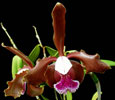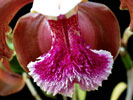|
|
|
|
|
| |
Flasks of
Cattleya granulosa var. schofieldiana 'MC20' × self |
|
| |
|
|
| |
| Number: |
TN1080 |
| Name: |
Cattleya granulosa var. schofieldiana 'MC20' × self
|
| Type: |
self (What's that?) |
|
Seed Donor: |
Dale Borders
|
|
Click to Enlarge

Pod Parent Flower |
Click to Enlarge

Pod Parent Closeup of Labellum |
|
|
|
| |
Culture Notes from Donor: Parent plant: Temperature range I (60-83°F)
For additional origin/habitat information supplied courtesy of
Charles and Margaret Baker, see further below, near the bottom of this page.
|
Temperatures we attempt to use in the lab & greenhouse:
| For Species: |
|
Spring, Summer, Autumn: days average 86°F, nights 77°F; best fit is Warm 90-70°F
(Source:
Baker's Web OSC) |
| For Species: |
|
Winter: days average 81°F, nights 72°F; best fit is Warm-Intermediate 87-64°F
(Source:
Baker's Web OSC) |
| For Genus: |
|
Spring, Summer, Autumn, Winter: days average 83°F, nights 60°F; best fit is Intermediate 83-60°F
(
) |
|
About the name...
| Etymology of |
Cattleya |
|
Named in honor of William Cattley, English horticulturist in the 19th century.
(Source:
Pridgeon 1992) |
| Etymology of |
granulosa |
|
From Latin "granulosus" granular. With granular spots.
(Source:
Mayr & Schmucker 1998) |
| Etymology of |
schofieldiana |
|
Named for G.W. Law-Schofield, an English orchid enthusiast from the 19th century.
(Source:
Mayr & Schmucker 1998) |
| Pronunciation of |
Cattleya |
|
KAT-lee-ya
(Sources:
Pridgeon 1992, Hawkes 1978) |
| Pronunciation of |
granulosa |
|
gran-yoo-LOW-sa
(Source:
Hawkes 1978) |
| Pronunciation of |
schofieldiana |
|
skoe-feeld-ee-AH-na
(Source:
Hawkes 1978) |
|
If you would like to direct someone to this web page, please copy and paste this URL into your email:
http://troymeyers.com/d?011080
| Flask Information |
| Availability: |
We have sold all of the flasks for this item. |
| You should: |
Consider getting individual plants or compots instead of a flask.
You can place a "Notify Flask Recipients" Request, and either we or a flask recipient may contact you when plants are available.
You may also place a "Notify Retries" Request, and if an identical pollination (the same parents) is done again, we'll let you know.
You may reserve a flask, but it's very unlikely you'll get one ...this could only happen if we found a flask that we didn't know we had. |
| Yield Estimate: |
570 plants (based on flask surveys done 11/26/2002 through 12/13/2002)
|
| Plantlet Sizes: |
From many flasks 8 - 35 mm plants (based on flask surveys done 11/24/2003 through 02/09/2004)
From one most recently surveyed flask 10 - 20 mm (02/09/2004)
|
|
You might also want to:
|
View the seed assay for this item.
View items of the same species.
View items of the same genus.
|
| Ordering Information |
| You are not currently logged in. |
|
You must be a registered user and be logged in to reserve a flask or place a notification request. Please log in:
|
|
|
|
|
|
| |
The origin/habitat information below is supplied courtesy of Charles and Margaret Baker
The following information is based on the name of the plant provided by the donor, and assumes that the name is correct. If the plant has been misidentified, then the following information may not be correct.
This text is copyrighted by the Bakers and may not be reproduced without permission.
ORIGIN/HABITAT: Brazil. In the state of Espírito Santo, plants grow on
moss- or lichen-covered trees on almost vertical northeast facing slopes
at 1300-2300 ft. (400-700 m), or in open forests of small trees less than
20-30 ft. (6-9 m) tall. This orchid grows 5-10 ft. (1.5-3.0 m) above the
ground where light is high; but in forests with tall 70-100 ft. (21-30 m)
trees, plants grow in the brighter light in the open crowns of the trees.
Cattleya schilleriana Rchb. f. and Cattleya velutina Rchb.f. grow in the
same area, sometimes even on the same trees. Cattleya harrisoniana Bateman
and Cattleya warneri Moore also grow in the same area, but they are
usually found on trees along the river instead of on the cliffs above it.
More about this information and the Bakers...
|
|
|
| |
|
|
|